Discover 35 hidden attractions, cool sights, and unusual things to do in Edinburgh (United Kingdom). Don't miss out on these must-see attractions: Edinburgh Castle, Palace of Holyroodhouse, and Scottish National Gallery. Also, be sure to include Calton Hill in your itinerary.
Below, you can find the list of the most amazing places you should visit in Edinburgh (Scotland).
Table of Contents
Edinburgh Castle
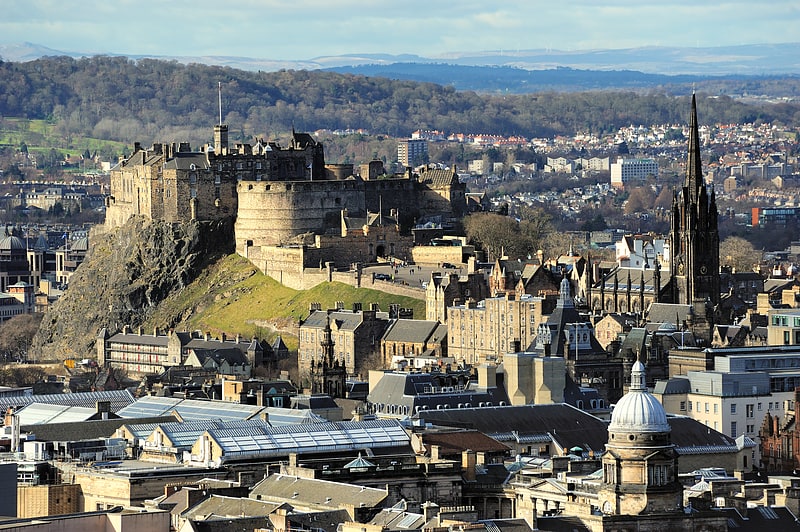
Spectacular old fortress with city views. Edinburgh Castle is a historic castle in Edinburgh, Scotland. It stands on Castle Rock, which has been occupied by humans since at least the Iron Age, although the nature of the early settlement is unclear. There has been a royal castle on the rock since at least the reign of David I in the 12th century, and the site continued to be a royal residence until 1633. From the 15th century, the castle's residential role declined, and by the 17th century it was principally used as military barracks with a large garrison. Its importance as a part of Scotland's national heritage was recognised increasingly from the early 19th century onwards, and various restoration programmes have been carried out over the past century and a half.
As one of the most important strongholds in the Kingdom of Scotland, Edinburgh Castle was involved in many historical conflicts from the Wars of Scottish Independence in the 14th century to the Jacobite rising of 1745. Research undertaken in 2014 identified 26 sieges in its 1,100-year history, giving it a claim to having been "the most besieged place in Great Britain and one of the most attacked in the world". Few of the present buildings pre-date the Lang Siege of the 16th century when the medieval defences were largely destroyed by artillery bombardment. The most notable exceptions are St Margaret's Chapel from the early 12th century, which is regarded as the oldest building in Edinburgh, the Royal Palace, and the early 16th-century Great Hall, although the interiors have been much altered from the mid-Victorian period onwards. The castle also houses the Scottish regalia, known as the Honours of Scotland, and is the site of the Scottish National War Memorial and the National War Museum of Scotland. The British Army is still responsible for some parts of the castle, although its presence is now largely ceremonial and administrative. Some of the castle buildings house regimental museums which contribute to its presentation as a tourist attraction.
The castle, in the care of Historic Environment Scotland, is Scotland's most and the United Kingdom's second most-visited paid tourist attraction, with over 2.2 million visitors in 2019 and over 70 percent of leisure visitors to Edinburgh visiting the castle. As the backdrop to the Royal Edinburgh Military Tattoo during the annual Edinburgh Festival, the castle has become a recognisable symbol of Edinburgh in particular and of Scotland as a whole.[1]
Palace of Holyroodhouse
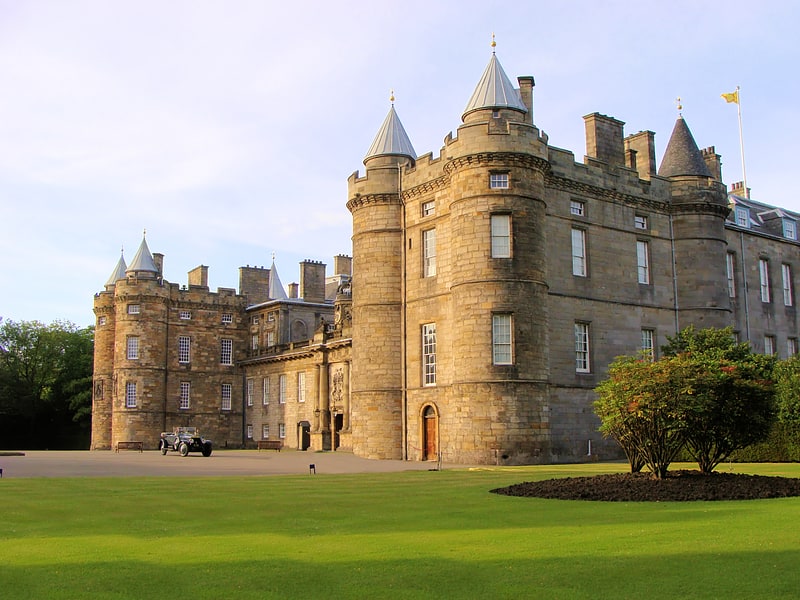
16th-century royal palace and abbey . The Palace of Holyroodhouse, commonly referred to as Holyrood Palace or Holyroodhouse, or Holyrood Castle, is the official residence of the British monarch in Scotland. Located at the bottom of the Royal Mile in Edinburgh, at the opposite end to Edinburgh Castle, Holyroodhouse has served as the principal royal residence in Scotland since the 16th century, and is a setting for state occasions and official entertaining.
Queen Elizabeth II spends one week in residence at Holyroodhouse at the beginning of each summer, where she carries out a range of official engagements and ceremonies. The 16th-century historic apartments of Mary, Queen of Scots, and the State Apartments, used for official and state entertaining, are open to the public throughout the year, except when members of the Royal Family are in residence. The Queen's Gallery was built at the western entrance to the Palace of Holyroodhouse and opened in 2002 to exhibit works of art from the Royal Collection. The gardens of the palace are set within Holyrood Park.[2]
Scottish National Gallery
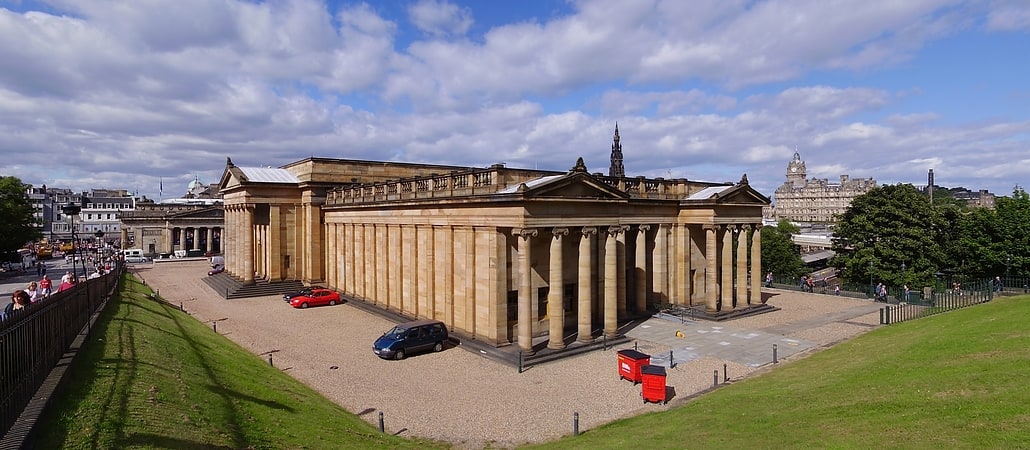
Old Masters and Scottish masterpieces. The Scottish National Gallery is the national art gallery of Scotland. It is located on The Mound in central Edinburgh, close to Princes Street. The building was designed in a neoclassical style by William Henry Playfair, and first opened to the public in 1859.
The gallery houses Scotland's national collection of fine art, spanning Scottish and international art from the beginning of the Renaissance up to the start of the 20th century.
The Scottish National Gallery is run by National Galleries of Scotland, a public body that also owns the Scottish National Gallery of Modern Art and the Scottish National Portrait Gallery. Because of its architectural similarity, the Scottish National Gallery is frequently confused by visitors with the neighbouring Royal Scottish Academy Building (RSA), a separate institution which works closely with the Scottish National Gallery.[3]
Address: The Mound, EH2 2EL Edinburgh (Old Town)
Calton Hill
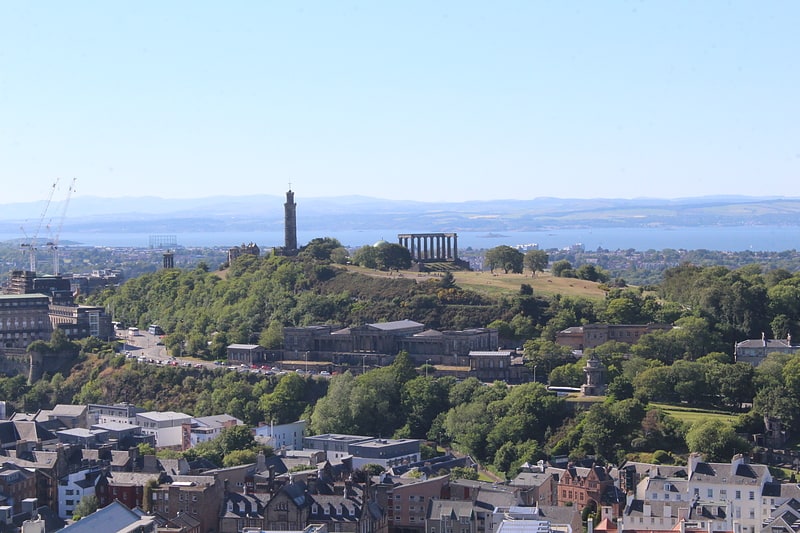
Views, gay bars and Edinburgh Playhouse. Calton Hill is a hill in central Edinburgh, Scotland, situated beyond the east end of Princes Street and included in the city's UNESCO World Heritage Site. Views of, and from, the hill are often used in photographs and paintings of the city.
Calton Hill is the headquarters of the Scottish Government, which is based at St Andrew's House, on the steep southern slope of the hill. The Scottish Parliament Building and other prominent buildings such as Holyrood Palace lie near the foot of the hill. Calton Hill is also the location of several monuments and buildings: the National Monument, the Nelson Monument, the Dugald Stewart Monument, the old Royal High School, the Robert Burns Monument, the Political Martyrs' Monument and the City Observatory.
The area lies between the Edinburgh districts of Greenside and Abbeyhill.[4]
Address: Regent Rd., EH1 3DG Edinburgh
Scott Monument
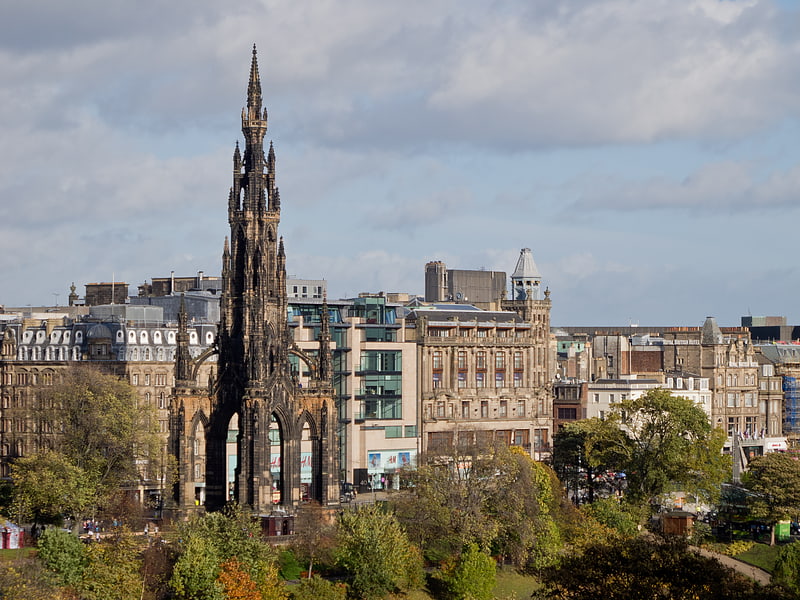
Iconic, Gothic Sir Walter Scott memorial. The Scott Monument is a Victorian Gothic monument to Scottish author Sir Walter Scott. It is the second largest monument to a writer in the world after the José Martí monument in Havana. It stands in Princes Street Gardens in Edinburgh, opposite the Jenners department store on Princes Street and near to Edinburgh Waverley Railway Station, which is named after Scott's Waverley novels.[5]
Address: Princes Street Gdns, EH2 2EJ Edinburgh (Old Town)
Princes Street Gardens
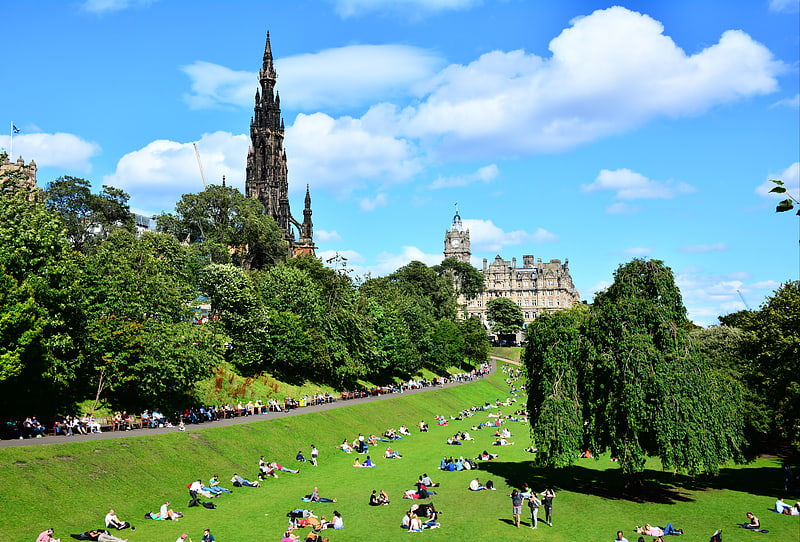
Landscaped gardens in Castle's shadow. Princes Street Gardens are two adjacent public parks in the centre of Edinburgh, Scotland, lying in the shadow of Edinburgh Castle. The Gardens were created in the 1820s following the long draining of the Nor Loch and building of the New Town, beginning in the 1760s.
The loch, situated on the north side of the town, was originally an artificial creation forming part of its medieval defences and made expansion northwards difficult. The water was habitually polluted from sewage draining downhill from the Old Town.
The gardens run along the south side of Princes Street and are divided by The Mound, on which the National Gallery of Scotland and the Royal Scottish Academy buildings are located. East Princes Street Gardens run from The Mound to Waverley Bridge, and cover 8.5 acres (3.4 ha). The larger West Princes Street Gardens cover 29 acres (12 ha) and extend to the adjacent churches of St. John's and St. Cuthbert's, near Lothian Road in the west.
In 1846 the railway was built in the valley to connect the Edinburgh-Glasgow line at Haymarket with the new northern terminus of the North British line from Berwick-upon-Tweed at Waverley Station.
The Gardens are the best known parks in Edinburgh, having the highest awareness and visitor figures for both residents and visitors to the city.[6]
Address: Princes St, EH2 2YJ Edinburgh (Old Town)
Arthur's Seat
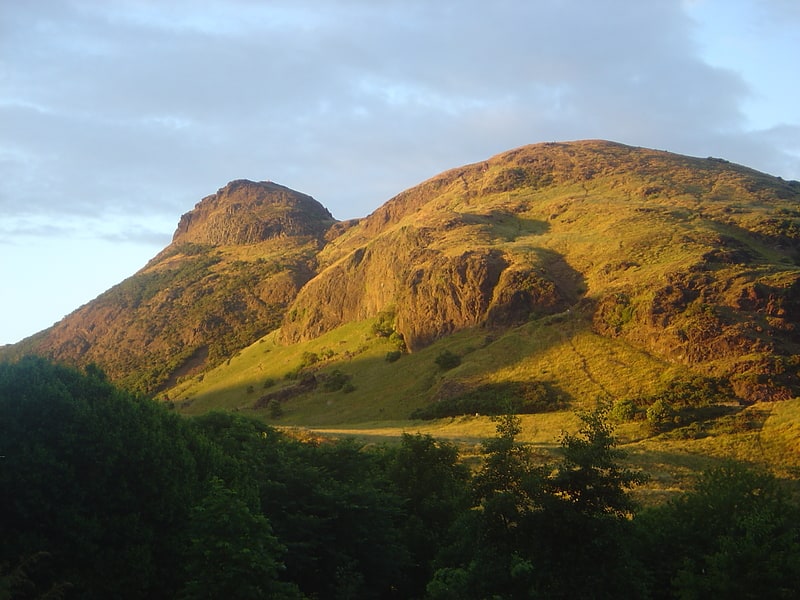
Peak known for hiking and sightseeing. Arthur's Seat is an ancient volcano which is the main peak of the group of hills in Edinburgh, Scotland, which form most of Holyrood Park, described by Robert Louis Stevenson as "a hill for magnitude, a mountain in virtue of its bold design". It is situated just to the east of the city centre, about 1 mile to the east of Edinburgh Castle. The hill rises above the city to a height of 250.5 m, provides excellent panoramic views of the city and beyond, is relatively easy to climb, and is popular for hillwalking. Though it can be climbed from almost any direction, the easiest and simplest ascent is from the east, where a grassy slope rises above Dunsapie Loch. At a spur of the hill, Salisbury Crags has historically been a rock climbing venue with routes of various degrees of difficulty, but due to hazards, rock climbing is now restricted to the South Quarry and a permit is required.[7]
Address: Holy Rood Park, EH16 5BT Edinburgh
Forth Bridge
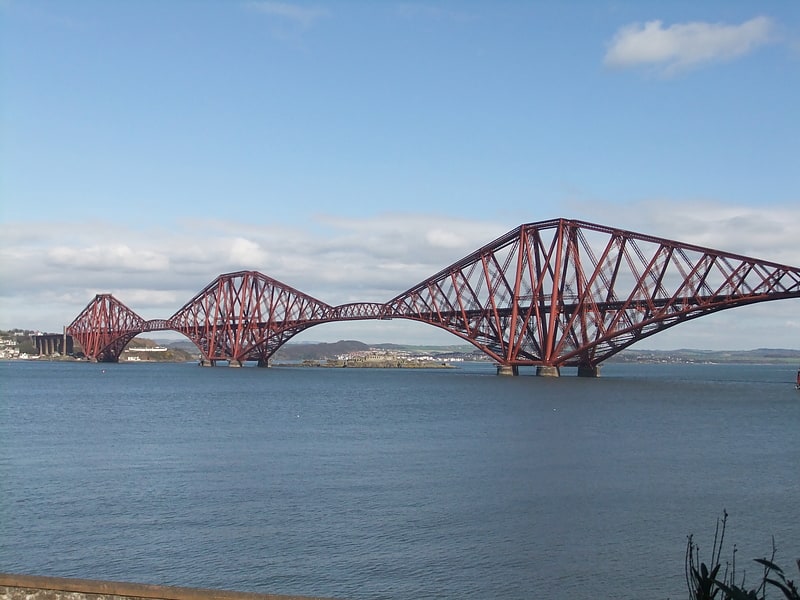
Iconic suspension bridge for traffic. The Forth Bridge is a cantilever railway bridge across the Firth of Forth in the east of Scotland, 9 miles west of central Edinburgh. Completed in 1890, it is considered as a symbol of Scotland, and is a UNESCO World Heritage Site. It was designed by English engineers Sir John Fowler and Sir Benjamin Baker. It is sometimes referred to as the Forth Rail Bridge, although this has never been its official name.
Construction of the bridge began in 1882 and it was opened on 4 March 1890 by the Duke of Rothesay, the future Edward VII. The bridge carries the Edinburgh–Aberdeen line across the Forth between the villages of South Queensferry and North Queensferry and has a total length of 8,094 feet (2,467 m). When it opened it had the longest single cantilever bridge span in the world, until 1919 when the Quebec Bridge in Canada was completed. It continues to be the world's second-longest single cantilever span, with a span of 1,709 feet (521 m).
The bridge and its associated railway infrastructure are owned by Network Rail.[8]
Address: Firth of Forth, K Y11 Fife
St Giles' Cathedral
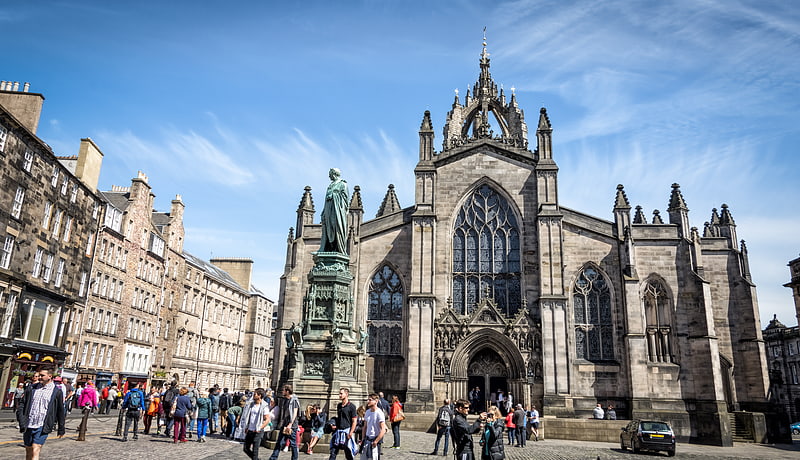
Iconic Presbyterian place of worship. St Giles' Cathedral, or the High Kirk of Edinburgh, is a parish church of the Church of Scotland in the Old Town of Edinburgh. The current building was begun in the 14th century and extended until the early 16th century; significant alterations were undertaken in the 19th and 20th centuries, including the addition of the Thistle Chapel. St Giles' is closely associated with many events and figures in Scottish history, including John Knox, who served as the church's minister after the Scottish Reformation.
Likely founded in the 12th century and dedicated to Saint Giles, the church was elevated to collegiate status by Pope Paul II in 1467. In 1559, the church became Protestant with John Knox, the foremost figure of the Scottish Reformation, as its minister. After the Reformation, St Giles' was internally partitioned to serve multiple congregations as well as secular purposes, such as a prison and as a meeting place for the Parliament of Scotland. In 1633, Charles I made St Giles' the cathedral of the newly created Diocese of Edinburgh. Charles' attempt to impose a Scottish Prayer Book in St Giles' on 23 July 1637 caused a riot, which precipitated the formation of the Covenanters and the beginnings of the Wars of the Three Kingdoms. The church's role in the Scottish Reformation and the Covenanters' Rebellion has led to its being called "the Mother Church of World Presbyterianism".
St Giles' is one of Scotland's most important medieval parish church buildings. The first church of St Giles' was a small, Romanesque building of which only fragments remain. In the 14th century, this was replaced by the current building, which was enlarged between the late 14th and early 16th centuries. The church was altered between 1829 and 1833 by William Burn and restored between 1872 and 1883 by William Hay with the support of William Chambers. Chambers hoped to make St Giles' a "Westminster Abbey for Scotland" by enriching the church and adding memorials to notable Scots. Between 1909 and 1911, the Thistle Chapel, designed by Robert Lorimer, was added to the church.
Since the medieval period, St Giles' has been the site of nationally important events and services; the services of the Order of the Thistle take place here. Alongside housing an active congregation, the church is one of Scotland's most popular visitor sites: it attracted over a million visitors in 2018.[9]
Address: 375 High St, EH1 1RE Edinburgh (Old Town)
Greyfriars Kirkyard
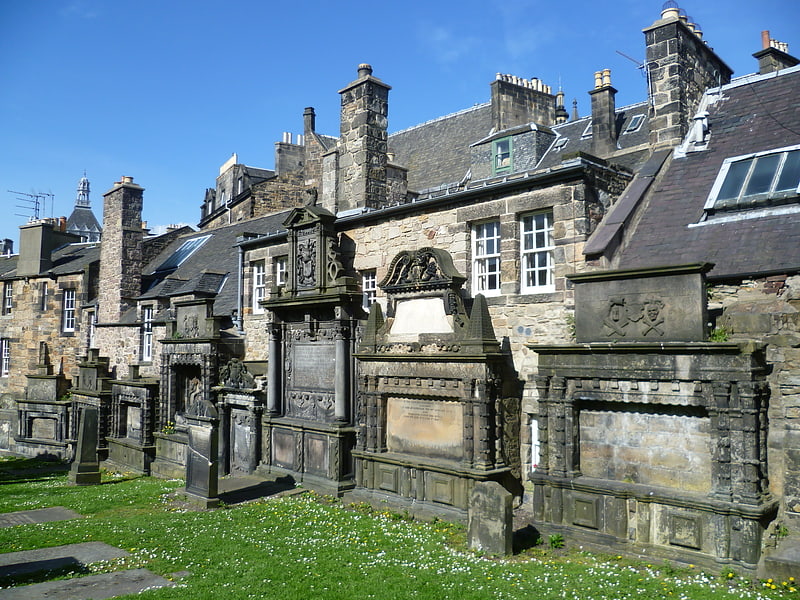
Graveyard. Greyfriars Kirkyard is the graveyard surrounding Greyfriars Kirk in Edinburgh, Scotland. It is located at the southern edge of the Old Town, adjacent to George Heriot's School. Burials have been taking place since the late 16th century, and a number of notable Edinburgh residents are interred at Greyfriars. The Kirkyard is operated by City of Edinburgh Council in liaison with a charitable trust, which is linked to but separate from the church. The Kirkyard and its monuments are protected as a category A listed building.[10]
Address: Candlemaker Row, EH1 2QQ Edinburgh
Scottish National Portrait Gallery
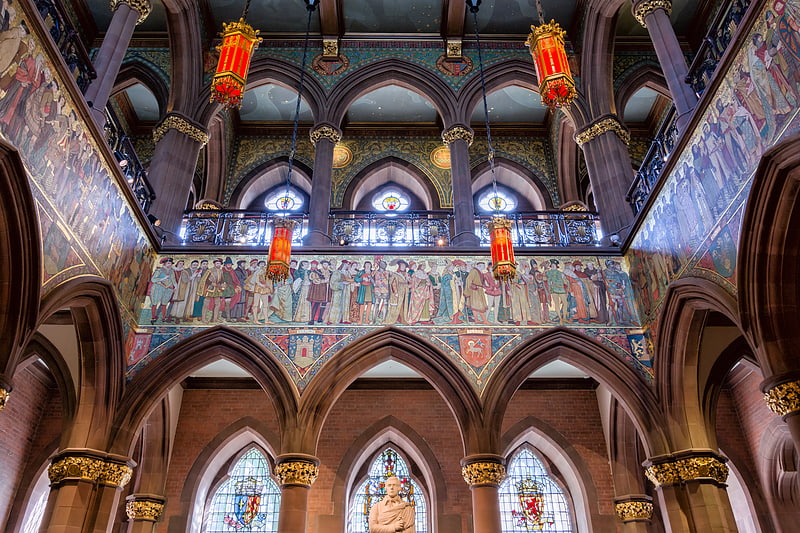
Victorian gallery of notable Scots. The Scottish National Portrait Gallery is an art museum on Queen Street, Edinburgh. The gallery holds the national collections of portraits, all of which are of, but not necessarily by, Scots. It also holds the Scottish National Photography Collection.
Since 1889 it has been housed in its red sandstone Gothic revival building, designed by Robert Rowand Anderson and built between 1885 and 1890 to accommodate the gallery and the museum collection of the Society of Antiquaries of Scotland. The building was donated by John Ritchie Findlay, owner of The Scotsman newspaper. In 1985 the National Museum of Antiquities of Scotland was amalgamated with the Royal Scottish Museum, and later moved to Chambers Street as part of the National Museum of Scotland. The Portrait Gallery expanded to take over the whole building, and reopened on 1 December 2011 after being closed since April 2009 for the first comprehensive refurbishment in its history, carried out by Page\Park Architects.
The Scottish National Portrait Gallery is part of National Galleries of Scotland, a public body that also owns the Scottish National Gallery of Modern Art and the Scottish National Gallery in Edinburgh.[11]
Address: 1 Queen St, EH2 1JD Edinburgh
The Museum of the Royal Scots and the Royal Regiment of Scotland
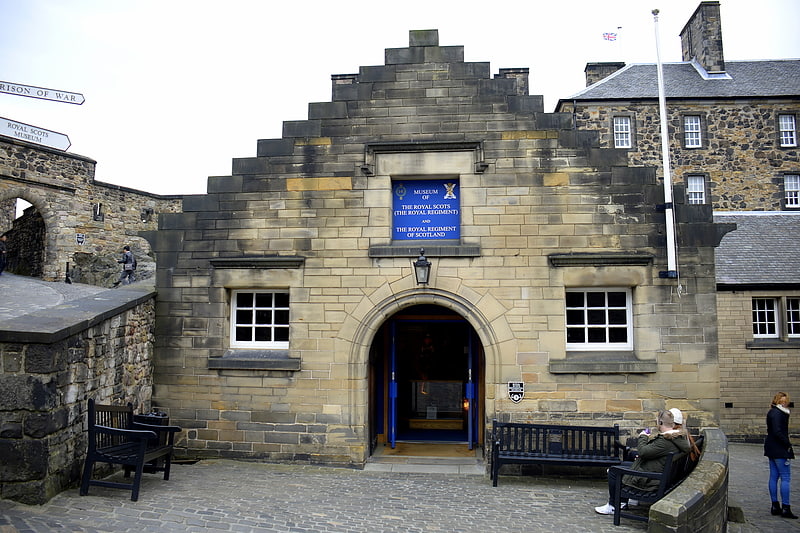
The Museum of the Royal Scots and the Royal Regiment of Scotland is a regimental museum displaying the collections of the Royal Scots and the Royal Regiment of Scotland. It is based in the Royal Scots drill hall at Edinburgh Castle in Scotland.[12]
Collective
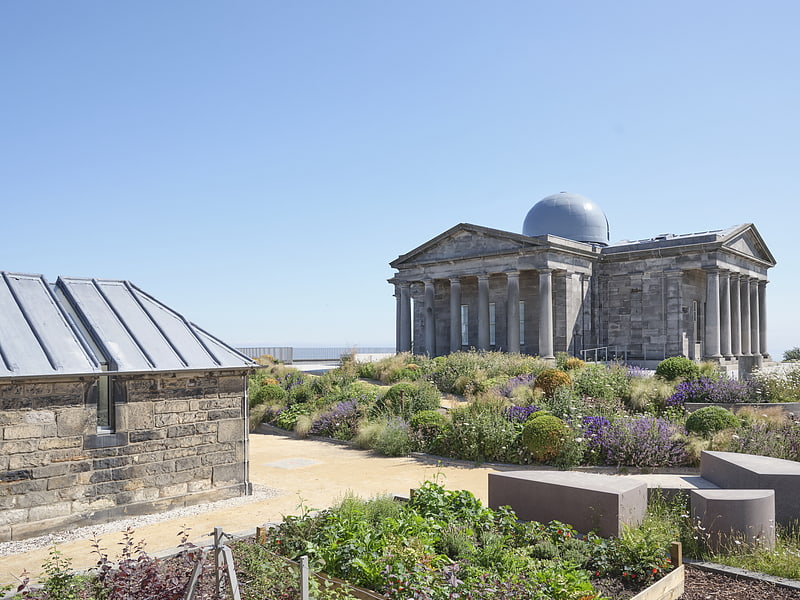
Collective is a contemporary art centre in Edinburgh, Scotland, created in 1984. It is situated on Calton Hill, in the former City Observatory and City Dome site. It offers a programme of exhibitions, guided walking tours, audio walking tours, and events.[13]
Address: 38 Calton Hill, EH7 5AA Edinburgh
National War Museum
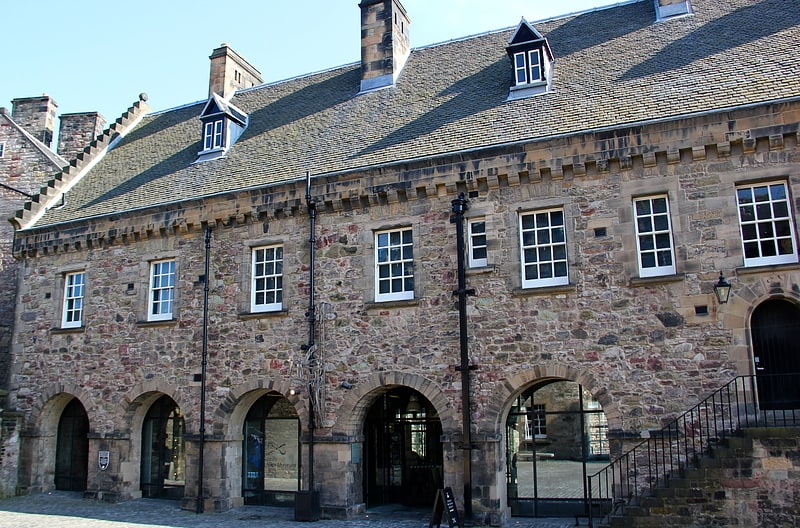
Military exhibitions at Edinburgh Castle. The National War Museum is a museum dedicated to warfare, which is located inside Edinburgh Castle in Edinburgh, Scotland. Opened in 1933 in a converted 18th-century ordnance storehouse, the museum is run by the National Museums Scotland and covers 400 years of Scotland at war from the 17th century through permanent exhibits and special exhibitions.
It was formerly known as the Scottish United Services Museum, and prior to this, the Scottish Naval and Military Museum.[14]
Address: Edinburgh Castle, EH1 2NG Edinburgh (Old Town)
Royal Scots Dragoon Guards Museum
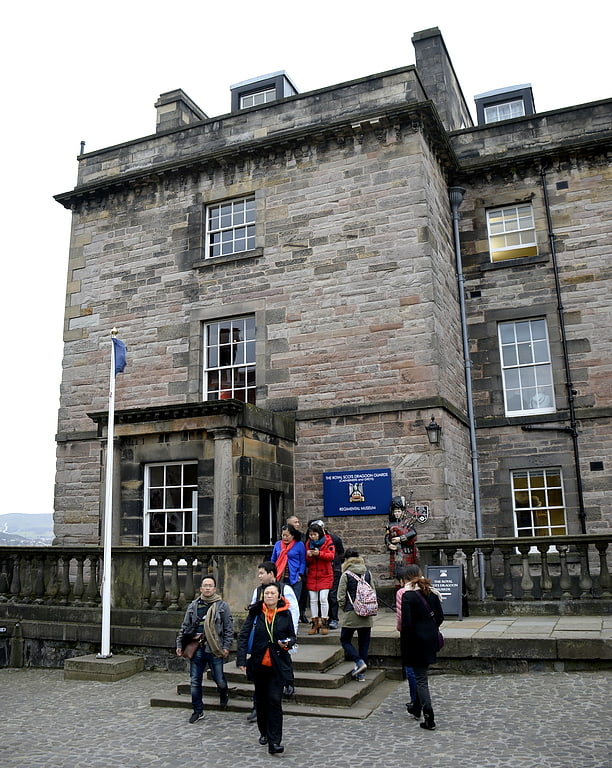
The Royal Scots Dragoon Guards Museum is a regimental museum displaying the collections of the Royal Scots Dragoon Guards and its predecessor regiments. It is based in the New Barracks at Edinburgh Castle in Scotland.[15]
Queen's Gallery
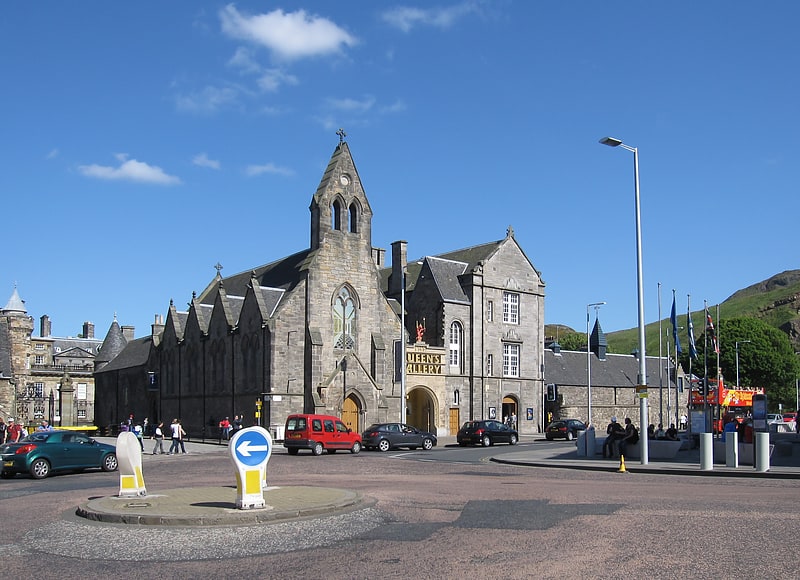
Art gallery in Edinburgh, Scotland. The Queen's Gallery is an art gallery in Edinburgh, Scotland. It forms part of the Palace of Holyroodhouse complex. It was opened in 2002 by Queen Elizabeth II, and exhibits works from the Royal Collection. It is open to the public daily.
This Victorian building was originally built as Holyrood Free Church (a congregation of the Free Church of Scotland, then from 1900 United Free Church of Scotland), but was last used for worship in 1915, see Redundant church. Prior to its conversion to become the Queen's Gallery the building was used as a storeroom.
There have been calls by some Scottish politicians to demolish or move the gallery building to create an uninterrupted square between Holyrood Palace and the Scottish Parliament Building.[16]
Address: The Royal Mile, EH8 8DX Edinburgh
The Scottish Parliament
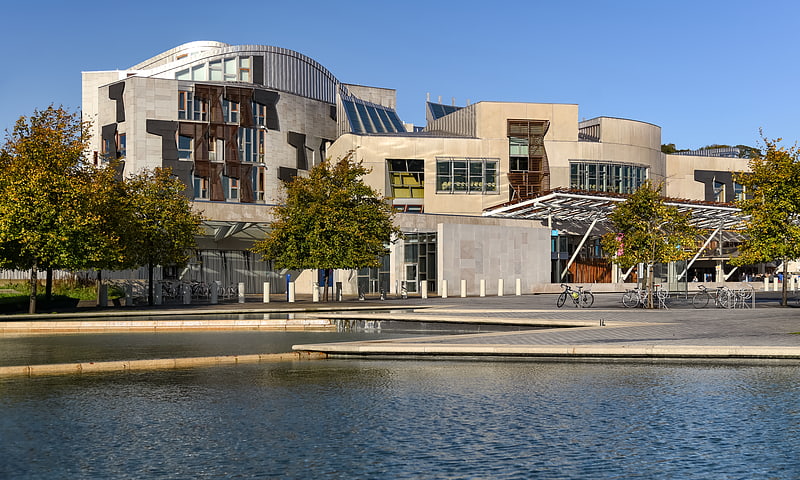
Striking modern government building. The Scottish Parliament Building is the home of the Scottish Parliament at Holyrood, within the UNESCO World Heritage Site in central Edinburgh. Construction of the building commenced in June 1999 and the Members of the Scottish Parliament held their first debate in the new building on 7 September 2004. The formal opening by Queen Elizabeth II took place on 9 October 2004. Enric Miralles, the Spanish architect who designed the building, died before its completion.
From 1999 until the opening of the new building in 2004, committee rooms and the debating chamber of the Scottish Parliament were housed in the General Assembly Hall of the Church of Scotland located on The Mound in Edinburgh. Office and administrative accommodation in support of the Parliament were provided in buildings leased from the City of Edinburgh Council. The new Scottish Parliament Building brought together these different elements into one purpose-built parliamentary complex, housing 129 MSPs and more than 1,000 staff and civil servants.
From the outset, the building and its construction have been controversial. The choices of location, architect, design, and construction company were all criticised by politicians, the media and the Scottish public. Scheduled to open in 2001, it did so in 2004, more than three years late with an estimated final cost of £414 million, many times higher than initial estimates of between £10m and £40m. A major public inquiry into the handling of the construction, chaired by the former Lord Advocate, Lord Fraser of Carmyllie, was established in 2003. The inquiry concluded in September 2004 and criticised the management of the whole project from the realisation of cost increases down to the way in which major design changes were implemented. Despite these criticisms and a mixed public reaction, the building was welcomed by architectural academics and critics. The building aimed to achieve a poetic union between the Scottish landscape, its people, its culture, and the city of Edinburgh. The Parliament Building won numerous awards including the 2005 Stirling Prize and has been described by landscape architect Charles Jencks as "a tour de force of arts and crafts and quality without parallel in the last 100 years of British architecture".[17]
Address: Horse Wynd / Canongate, Royal MIle, EH99 1SP Edinburgh (Old Town)
Gladstone's Land
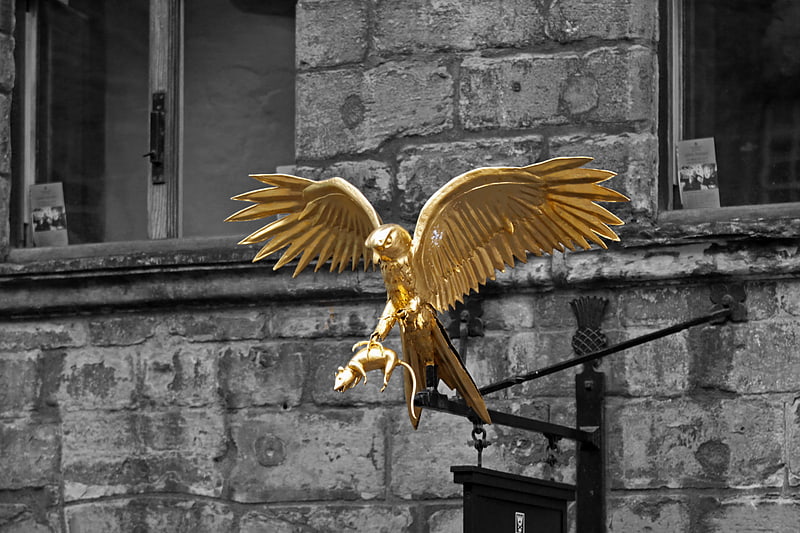
Tourist attraction in Edinburgh, Scotland. Gladstone's Land is a surviving 17th-century high-tenement house situated in the Old Town of the city of Edinburgh, Scotland. It has been restored and furnished by the National Trust for Scotland, and is operated as a popular tourist attraction.[18]
Address: 477B Lawnmarket, EH1 2NT Edinburgh (Old Town)
HMY Britannia

Royal family's former personal vessel. Her Majesty's Yacht Britannia, also known as the Royal Yacht Britannia, is the former royal yacht of the British monarch, Queen Elizabeth II, in service from 1954 until 1997. She was the 83rd such vessel since King Charles II acceded to the throne in 1660, and is the second royal yacht to bear the name, the first being the racing cutter built for the Prince of Wales in 1893. During her 43-year career, the yacht travelled more than a million nautical miles around the globe. Now retired from royal service, Britannia is permanently berthed at Ocean Terminal, Leith in Edinburgh, Scotland. It is a popular visitor attraction with over 300,000 visits each year.[19]
Address: 1 Ocean Dr, EH6 6JB Edinburgh (Leith)
National Museum of Scotland
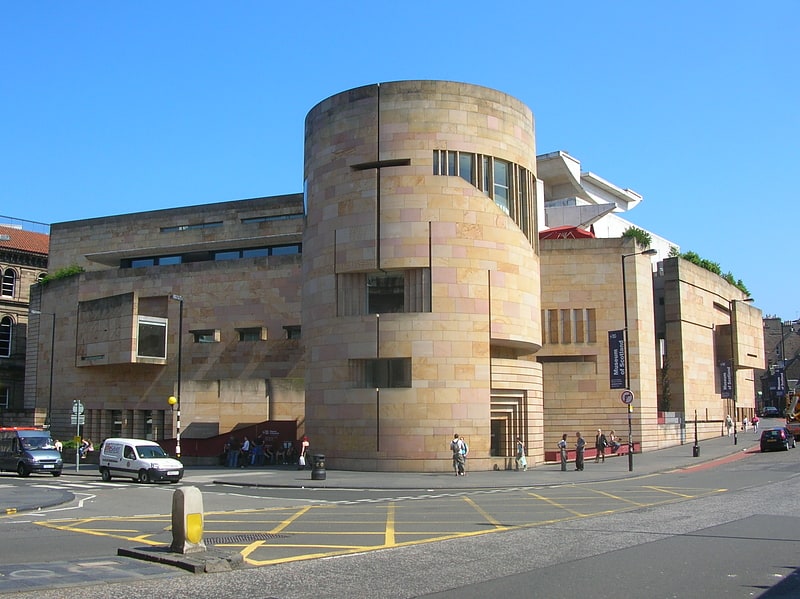
Natural history and industrial exhibits. The National Museum of Scotland in Edinburgh, Scotland, was formed in 2006 with the merger of the new Museum of Scotland, with collections relating to Scottish antiquities, culture and history, and the adjacent Royal Scottish Museum, with international collections covering science and technology, natural history, and world cultures. The two connected buildings stand beside each other on Chambers Street, by the intersection with the George IV Bridge, in central Edinburgh. The museum is part of National Museums Scotland. Admission is free.
The two buildings retain distinctive characters: the Museum of Scotland is housed in a modern building opened in 1998, while the former Royal Museum building was begun in 1861 and partially opened in 1866, with a Victorian Venetian Renaissance facade and a grand central hall of cast iron construction that rises the full height of the building, design by Francis Fowke and Robert Matheson. This building underwent a major refurbishment and reopened on 29 July 2011 after a three-year, £47 million project to restore and extend the building led by Gareth Hoskins Architects along with the concurrent redesign of the exhibitions by Ralph Appelbaum Associates.
The National Museum incorporates the collections of the former National Museum of Antiquities of Scotland. As well as the national collections of Scottish archaeological finds and medieval objects, the museum contains artefacts from around the world, encompassing geology, archaeology, natural history, science, technology, art, and world cultures. The 16 new galleries reopened in 2011 include 8,000 objects, 80 per cent of which were not formerly on display. One of the more notable exhibits is the stuffed body of Dolly the sheep, the first successful cloning of a mammal from an adult cell. Other highlights include Ancient Egyptian exhibitions, one of Elton John's extravagant suits, the Jean Muir Collection of costume and a large kinetic sculpture named the Millennium Clock. A Scottish invention that is a perennial favourite with school parties is the Scottish Maiden, an early beheading machine predating the guillotine.
In 2019, the museum received 2,210,024 visitors, making it Scotland's most popular visitor attraction that year.[20]
Address: Chambers St, EH1 1JF Edinburgh (Southside)
Castle Rock

Summit in Scotland. Castle Rock is a volcanic plug in the middle of Edinburgh upon which Edinburgh Castle sits. The rock is estimated to have formed some 350 million years ago during the early Carboniferous period. It is the remains of a volcanic pipe which cut through the surrounding sedimentary rock, before cooling to form very hard dolerite, a coarser-grained equivalent of basalt. Subsequent glacial erosion was resisted more by the dolerite, which protected the softer rock to the east, leaving a crag and tail formation.
The summit of the castle rock is 130 metres (430 ft) above sea level, with rocky cliffs to the south, west and north, rearing up to 80 metres (260 ft) from the surrounding landscape. This means that the only readily accessible route to the castle lies to the east, where the ridge slopes more gently. The defensive advantage of such a site is clear, but the geology of the rock also presents difficulties, since basalt is an extremely poor aquifer. Providing water to the Upper Ward of the castle was problematic, and despite the sinking of a 28-metre (92 ft) deep well, the water supply often ran out during drought or siege, for example during the Lang Siege of 1573.[21]
Address: The Royal Mile, EH15 2HF Edinburgh (Old Town)
St Cuthbert's Church
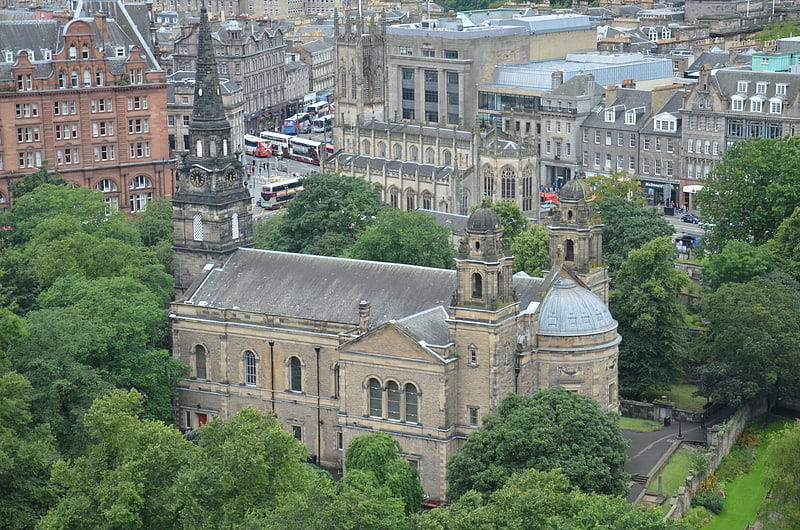
Parish church in Edinburgh, Scotland. The Parish Church of St Cuthbert is a parish church of the Church of Scotland in central Edinburgh. Probably founded in the 7th century, the church once covered an extensive parish around the burgh of Edinburgh. The church's current building was designed by Hippolyte Blanc and completed in 1894.
St Cuthbert's is situated within a large churchyard that bounds Princes Street Gardens and Lothian Road. A church was probably founded on this site during or shortly after the life of Cuthbert. The church is first recorded in 1128, when David I granted it to Holyrood Abbey. At that time, the church covered an extensive parish, which was gradually reduced until the 20th century by the erection and expansion of other parishes, many of which were founded as chapels of ease of St Cuthbert's. St Cuthbert's became a Protestant church at the Scottish Reformation in 1560: from after the Reformation until the 19th century, the church was usually called the West Kirk. After the Restoration in 1660, the congregation remained loyal to the Covenanters. The church's position at the foot of Castle Rock saw it damaged or destroyed at least four times between the 14th and 17th centuries.
The current church was built between 1892 and 1894 to replace a Georgian church, which had itself replaced a building of uncertain age. The building was designed by Hippolyte Blanc in the Baroque and Renaissance styles and retains the steeple of the previous church. The Buildings of Scotland guide to Edinburgh calls the church's furnishings "extraordinary". Features include stained glass windows by Louis Comfort Tiffany, Douglas Strachan, and Ballantyne & Gardiner; mural paintings by Gerald Moira and John Duncan; and memorials by John Flaxman and George Frampton. The church also possesses a ring of ten bells by Taylor of Loughborough. The church has been a Category A listed building since 1970.
Seven of the church's ministers have served as Moderator of the General Assembly of the Church of Scotland during their incumbencies, including Robert Pont, who held the role on six occasions between the 1570s and 1590s. The church's present work includes ministries among homeless people and Edinburgh's business community.[22]
Address: 5 Lothian Rd., EH1 2EP Edinburgh (Old Town)
John Knox House
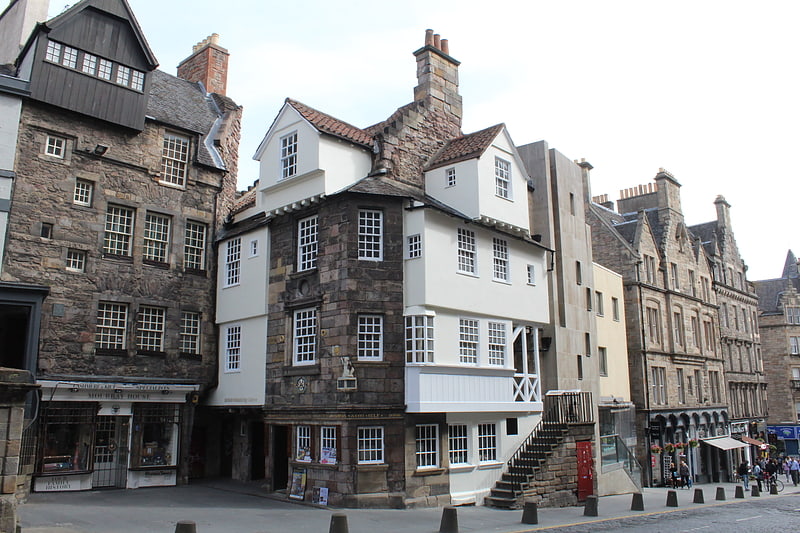
Local history museum in Edinburgh, Scotland. John Knox House, popularly known as John Knox's House, is an historic house in Edinburgh, Scotland, reputed to have been owned and lived in by Protestant reformer John Knox during the 16th century. Although his name became associated with the house, he appears to have lived in Warriston Close where a plaque indicates the approximate site of his actual residence.[23]
Address: High St, EH1 1SR Edinburgh (Old Town)
St Margaret's Well

Historical landmark in Edinburgh, Scotland. St Margaret's Well is a Category B listed holy well that was relocated to Holyrood Park off Queen's Drive in Edinburgh from Restalrig in 1860. It is one of seven wells located in the park.[24]
National Monument of Scotland
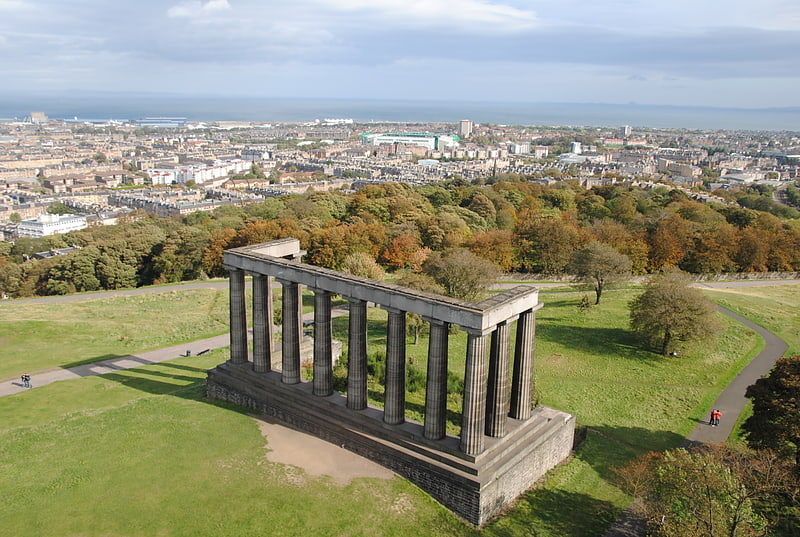
Cafe in Edinburgh, Scotland. The National Monument of Scotland, on Calton Hill in Edinburgh, is Scotland's national memorial to the Scottish soldiers and sailors who died fighting in the Napoleonic Wars. It was intended, according to the inscription, to be "A Memorial of the Past and Incentive to the Future Heroism of the Men of Scotland".
The monument dominates the top of Calton Hill, just to the east of Princes Street. It was designed during 1823–6 by Charles Robert Cockerell and William Henry Playfair and is modelled upon the Parthenon in Athens. Construction started in 1826 and, due to the lack of funds, was left unfinished in 1829. This circumstance gave rise to various nicknames such as "Scotland's Folly", "Edinburgh's Disgrace", "the Pride and Poverty of Scotland" and "Edinburgh's Folly".[25]
Address: Carlton Hill, EH7 5AA Edinburgh
Holyrood Abbey
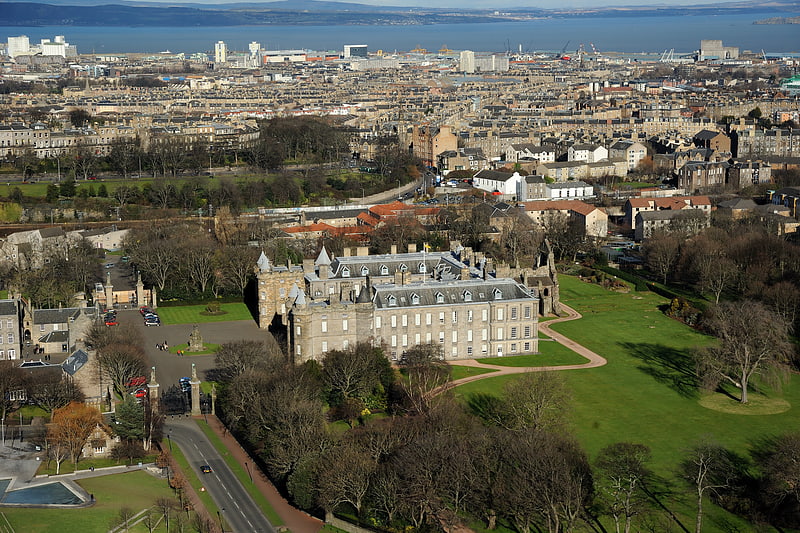
Picturesque remains of an 1128 abbey. Holyrood Abbey is a ruined abbey of the Canons Regular in Edinburgh, Scotland. The abbey was founded in 1128 by David I of Scotland. During the 15th century, the abbey guesthouse was developed into a royal residence, and after the Scottish Reformation the Palace of Holyroodhouse was expanded further. The abbey church was used as a parish church until the 17th century, and has been ruined since the 18th century. The remaining walls of the abbey lie adjacent to the palace, at the eastern end of Edinburgh's Royal Mile. The site of the abbey is protected as a scheduled monument.[26]
Address: Palace of Holyroodhouse Holyrood Rd, EH8 8DX Edinburgh
Scottish National War Memorial

War memorial in Edinburgh, Scotland. The Scottish National War Memorial is located in Edinburgh Castle and commemorates Scottish service personnel and civilians, and those serving with Scottish regiments, who died in the two world wars and subsequent conflicts. Its chief architect was Robert Lorimer, commissioned in 1919, and the monument was formally opened in 1927. It is housed in a redeveloped barrack block in Crown Square, at the heart of the castle, and incorporates numerous monuments.
The Rolls of Honour kept in the memorial include the names of those Scots servicemen and women and Scots civilians that died in all wars after 1914. This includes all Scots who were killed as a result of enemy action or who died as a result of wounds, diseases, or injuries while serving in the British Armed Forces, the Merchant Navy, the armed forces of the Dominions, the women's services, and the nursing services, together with all members of Scottish regiments. The Rolls of Honour include those who died between 4 August 1914 and 31 August 1921 as having died in the First World War and those between 3 September 1939 and 31 December 1947 as having died in the Second World War. Those not serving in the Scottish regiments must either have been born in Scotland or have at least one parent born in the country.
The memorial rolls list close to 135,000 casualties of the First World War and over 50,000 of the Second World War. More casualties from later wars are also inscribed, including from the Malayan Emergency, the Korean War (1950–1953), Operation Banner (1969–2007) during The Troubles, the Falklands War (1982), and the Gulf War (1990–1991).[27]
Address: Edinburgh Castle, Edinburgh (Old Town)
Witches' Well
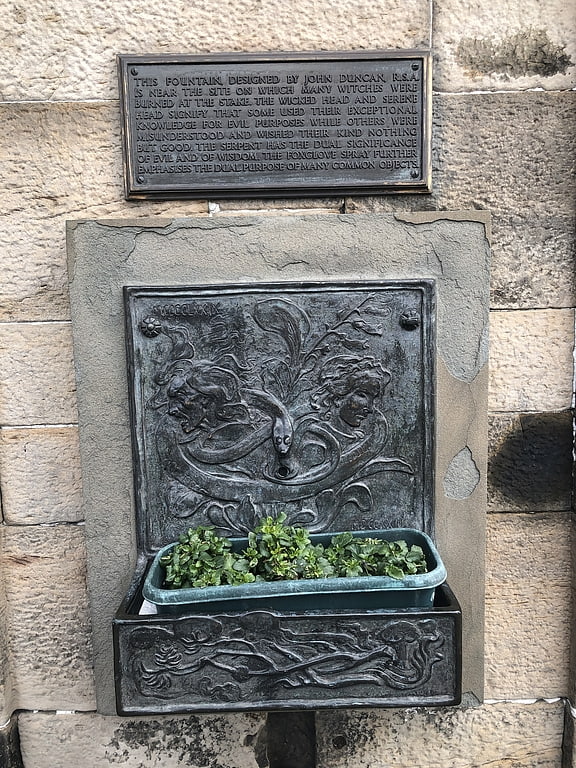
The Witches' Well is a monument to accused witches burned at the stake in Edinburgh, Scotland, and is the only one of its kind in the city.
The memorial drinking fountain is attached to a wall at the lower end of the Castle Esplanade, below Edinburgh Castle, and located close to where many witches were burned at the stake. During the high point of witch hunting in the early modern period, 32% of accused witches came from the Lothian area.[28]
Dynamic Earth
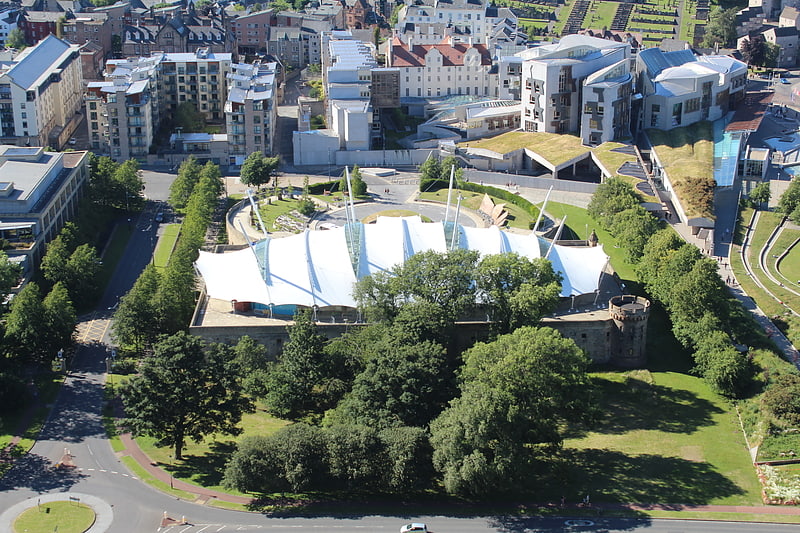
Building in Edinburgh, Scotland. Dynamic Earth is a not-for-profit visitor attraction and science centre in Edinburgh and is Scotland's largest interactive visitor attraction. It is located in the Holyrood area, beside the Scottish Parliament building and at the foot of Salisbury Crags. It is a registered charity under Scottish law and is owned as The Dynamic Earth Charitable Trust. The centre was opened by Queen Elizabeth II in 1999.
The project is located close to where renowned Scottish geologist James Hutton lived and worked in the city in the 18th century. The Dynamic Earth Trust says its aim is: "to consistently be the most fun place to play, learn and work.” A permanent visitor attraction which presents the story of the planet - how it was created; how it continues to evolve, the prospects for mankind and the effect of hazards both natural and manmade."[29]
Address: 112 Holyrood Rd, EH8 8AS Edinburgh (Old Town)
Murrayfield Stadium
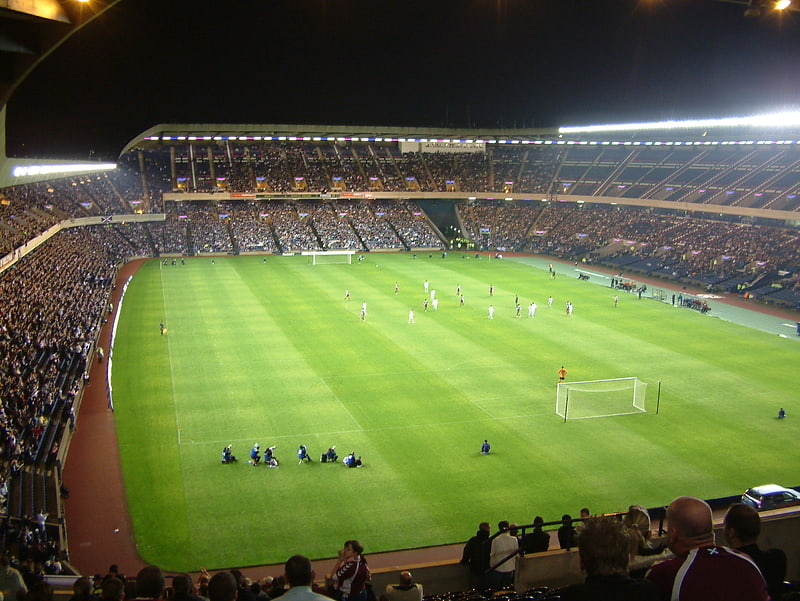
Stadium in Edinburgh, Scotland. Murrayfield Stadium is a Rugby stadium located in the Murrayfield area of Edinburgh, Scotland. It has a seating capacity of 67,144 making it the largest stadium in Scotland and the fifth largest in the United Kingdom.
The stadium is the home of the Scottish Rugby Union (SRU) and is mainly used as a venue for rugby union. The stadium hosts most of Scotland's home test matches and the Scottish Hydro Electric Cup final, as well as Pro14 and European Rugby Champions Cup matches.
Although primarily a rugby union stadium, Murrayfield has in the past hosted American football, rugby league and association football matches, as well as numerous music concerts.[30]
Address: Roseburn St, EH12 5PJ Edinburgh
Holyrood Park
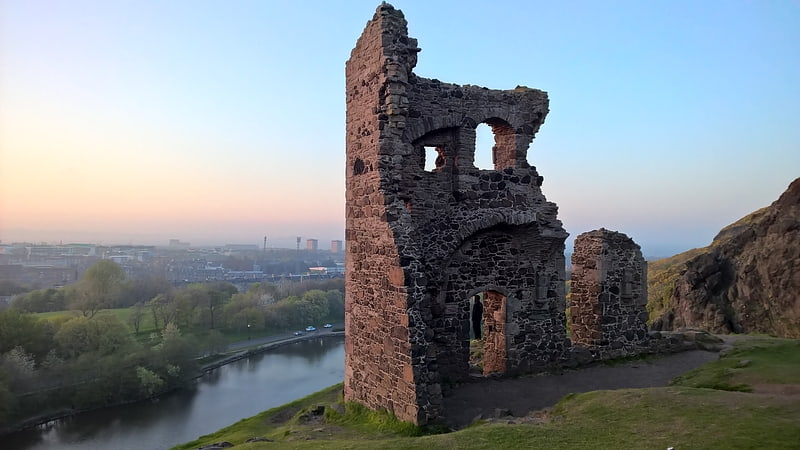
Skyline walks to Arthur's Seat. Holyrood Park is a royal park in central Edinburgh, Scotland about 1 mile to the east of Edinburgh Castle. It is open to the public. It has an array of hills, lochs, glens, ridges, basalt cliffs, and patches of gorse, providing a wild piece of highland landscape within its 650-acre area. The park is associated with the royal palace of Holyroodhouse and was formerly a 12th-century royal hunting estate. The park was created in 1541 when James V had the ground "circulit about Arthurs Sett, Salisborie and Duddingston craggis" enclosed by a stone wall.
Arthur's Seat, an extinct volcano and the highest point in Edinburgh, is at the centre of the park, with the cliffs of Salisbury Crags to the west. There are three lochs: St Margaret's Loch, Dunsapie Loch, and Duddingston Loch. The ruined St Anthony's Chapel stands above St Margaret's Loch. Queen's Drive is the main route through the Park, and is partly closed on Sundays to motor vehicles. St Margaret's Well and St Anthony's Well are both natural springs within the park. Holyrood Park is located to the south-east of the Old Town, at the edge of the city centre. Abbeyhill is to the north, and Duddingston village to the east. The University of Edinburgh's Pollock Halls of Residence are to the south-west, and Dumbiedykes is to the west.
Holyrood Park is one of Scotland's Properties in Care, owned by Scottish Ministers and managed on their behalf by Historic Environment Scotland.[31]
Address: Queens Drive, Edinburgh
Nelson Monument

Tower in Edinburgh, Scotland. The Nelson Monument is a commemorative tower in honour of Vice Admiral Horatio Nelson, located in Edinburgh, Scotland. It is situated on top of Calton Hill, and provides a dramatic termination to the vista along Princes Street from the west. The monument was built between 1807 and 1816 to commemorate Nelson's victory over the French and Spanish fleets at the Battle of Trafalgar in 1805, and his own death at the same battle. In 1852 a mechanized time ball was added, as a time signal to shipping in Leith harbour. The time ball is synchronized with the One O'Clock Gun firing from Edinburgh Castle. The monument was restored in 2009.
The Royal Navy's White Ensign and signal flags spelling out Nelson's famous message "England expects that every man will do his duty" are flown from the monument on Trafalgar Day each year.[32]
Address: 32 Calton Hill, EH7 5AA Edinburgh
Edinburgh Zoo

Panda enclosure and UK's only koalas. Edinburgh Zoo, formerly the Scottish National Zoological Park, is an 82-acre non-profit zoological park in the Corstorphine area of Edinburgh, Scotland.
The land lies on the south facing slopes of Corstorphine Hill, from which it provides extensive views of the city. Built in 1913, and owned by the Royal Zoological Society of Scotland, it receives over 600,000 visitors a year, which makes it Scotland's second most popular paid-for tourist attraction, after Edinburgh Castle. As well as catering to tourists and locals, the zoo is involved in many scientific pursuits, such as captive breeding of endangered animals, researching into animal behaviour, and active participation in various conservation programs around the world.
Edinburgh Zoo was the first zoo in the world to house and to breed penguins. It is also the only zoo in Britain to house Queensland koalas and giant pandas. The zoo is a member of the British and Irish Association of Zoos and Aquariums (BIAZA), the European Association of Zoos and Aquaria (EAZA), the World Association of Zoos and Aquariums (WAZA), and the Association of Scottish Visitor Attractions. It has also been granted four stars by the Scottish Tourism Board. The zoo gardens boast one of the most diverse tree collections in the Lothians.[33]
Address: 134 Corstorphine Rd, EH12 6TS Edinburgh
Thistle Chapel

The Thistle Chapel, located in St Giles' Cathedral, Edinburgh, Scotland, is the chapel of the Order of the Thistle.
At the foundation of the Order of the Thistle in 1687, James VII ordered Holyrood Abbey be fitted out as a chapel for the Knights. At James' deposition the following year, a mob destroyed the Chapel's interior before the Knights ever met there. In the 19th and early 20th centuries, multiple proposals were made either to refurbish Holyrood Abbey for the Order of the Thistle or to create a chapel within St Giles' Cathedral. In 1906, after the sons Ronald Leslie-Melville, 11th Earl of Leven donated £24,000 from their late father's estate, Edward VII ordered a new Chapel to be constructed on the south side of St Giles'.
The Trustees appointed by the King to oversee the Chapel's construction appointed Robert Lorimer as architect. The Trustees insisted the choice of craftspeople should reflect the national character of the Chapel. Lorimer assembled a team of leading figures in the Scottish Arts and Crafts movement, including Phoebe Anna Traquair for enamelwork, Douglas Strachan for stained glass, Joseph Hayes for stonework, and the brothers William and Alexander Clow for woodwork. Louis Davis – who supplied stained glass – and the Bromsgrove Guild – who supplied bronze fittings – were the only major contributors based outside Scotland. Construction began in November 1909 and the Chapel was completed a little over a year later. After its official opening in July 1911, George V knighted Lorimer for his work. Through the continuing addition of stall plates, crests, and banners for new Knights, the Chapel's tradition of craftsmanship persists to the present day. The Knights of the Thistle meet in the Chapel at least once a year.
Architectural critics have noted Lorimer's successful use of a limited site to create a soaring work of Gothic architecture, rich with architectural details. A number of critics have emphasised the Chapel's importance as a product of the Arts and Crafts movement, in which the collaborative craftsmanship of individual artisans defines the overall effect. Some critics have also emphasised the Chapel's political role as an expression of Scottish patriotism, British imperialism, and monarchism.[34]
Museum on the Mound
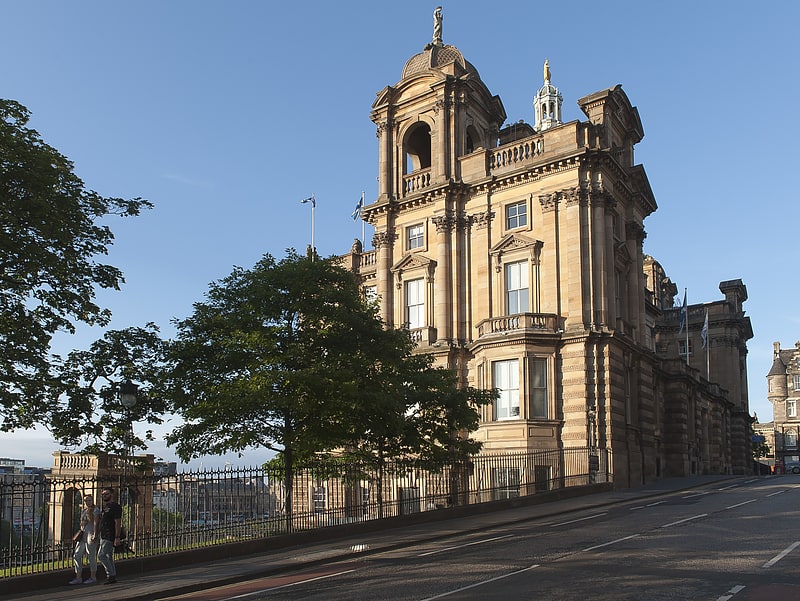
Museum in Edinburgh, Scotland. The Museum on the Mound is a museum in Edinburgh, Scotland, that focuses on money, coinage and economics. It is located in the Bank of Scotland Head Office building on The Mound. It has more than 50,000 visitors per year.[35]
Address: The Mound, EH1 1YZ East Lothian (Old Town)